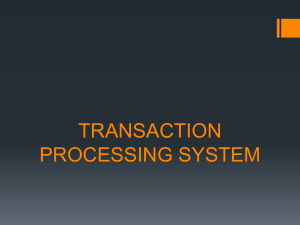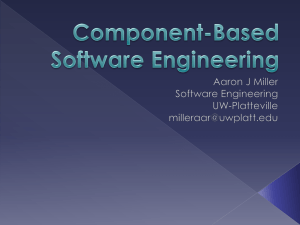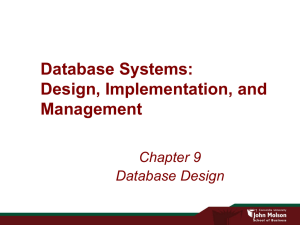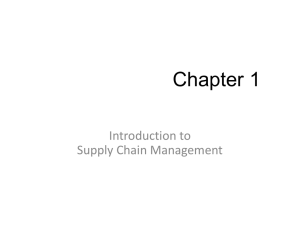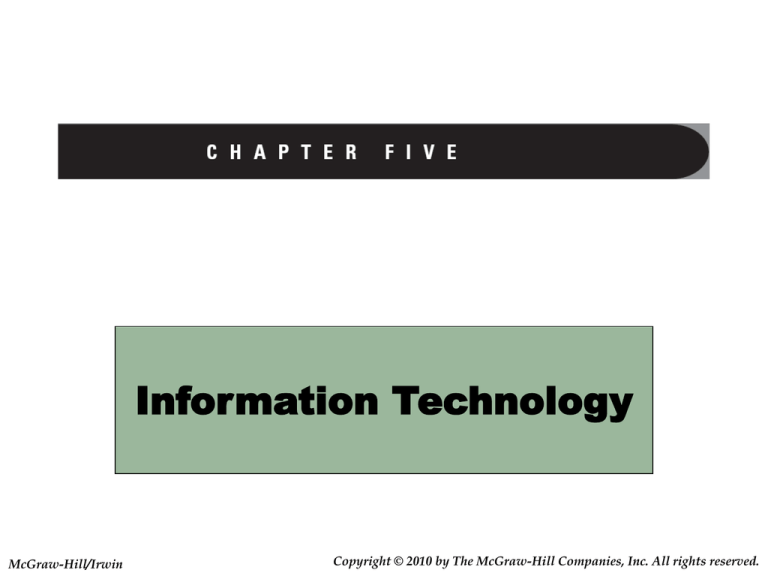
Information Technology
McGraw-Hill/Irwin
Copyright © 2010 by The McGraw-Hill Companies, Inc. All rights reserved.
Overview of information technology
• Information system functionality
• Supply chain information system
modules
• Enterprise operations
• Enterprise planning and monitoring
• Communication technology
• Software as a service
5-2
4 reasons why information is so critical in
logistics
• Customers perceive information as necessary dimensions
of customer accommodation
• Managers realize that information can be used to reduce
inventory and human resource requirements
• Information increases flexibility with regard to how, when
and where resources may be utilized to achieve strategic
advantage
• Enhanced information exchange over the Internet facilitates
collaboration and redefines supply chain relationships
5-3
Supply Chain Information Systems (SCIS)
• The thread that links logistical activities into an
integrated process
• Four levels of functionality
–
–
–
–
Transaction system
Management control
Decision analysis (aka decision support)
Strategic planning
5-4
Logistics activities and decisions at each
level of functionality
Figure 5.1 Information Functionality
5-5
Transaction system functionality consists of
formalized rules and procedures
• Standardized
communications focus on
tracking and regulating
day-to day logistical
transactions
• For example,
–
–
–
–
Order entry
Order fulfillment
Inventory adjustment
Invoicing
5-6
Logistics activities and decisions at each
level of functionality
Figure 5.1 Information Functionality
5-7
Management control functionality focuses on
performance management and reporting
• Provides real time feedback on
supply chain performance and
resource utilization
• Common performance
dimensions include
–
–
–
–
Cost
Customer service
Productivity
Quality
5-8
Logistics activities and decisions at each
level of functionality
Figure 5.1 Information Functionality
5-9
Decision analysis functionality focuses on
software tools to assist managers
• Software tools help to identify,
evaluate and compare
alternatives to improve
effectiveness
– E.g., Excel solver
• Types of analysis include
–
–
–
–
–
Supply chain design
Inventory management
Resource allocation
Routing
Segmental profitability
• Also called decision support
software in MIS departments
5-10
Logistics activities and decisions at each
level of functionality
Figure 5.1 Information Functionality
5-11
Strategic planning functionality transforms
transactional data to assist in strategy evaluation
• Organizes transaction and
performance data into a
relational database to assist in
evaluating alternative business
strategies
• Examples include
– Strategic alliance decisions
– Development of manufacturing
capabilities
– Customer responsiveness
opportunities
5-12
More opportunities exist for improvements at
higher levels of functionality
Figure 5.2 SCIS Usage, Decision Characteristics, and Justification
5-13
Enterprise resource management (ERP)
• The backbone of most firm’s logistical information systems
• Maintains an integrated database of current and historical
data
• Processes most (if not all) transactions across all business
functions
• Example transactions include
– Order entry and management
– Inventory assignment
– Shipping
5-14
Table 5.1 ERP System Capabilities
5-15
Application oriented perspective of SCIS modules
Figure 5.4 Application Oriented SCIS Framework
5-16
Application-oriented modules
•
•
•
•
ERP Data Warehouse
Enterprise Integration and Administration
Enterprise Planning and Monitoring
Enterprise Operations
5-17
ERP data warehouse is the core of an ERP system
• Central database is the relational information repository for
the entire ERP system
–
–
–
–
–
–
–
–
Customer file
Product-price file
Supplier file
Order file
Bill-of-materials file
Purchase order file
Inventory file
History file
5-18
Enterprise integration and administration modules
are not specific supply chain apps
Figure 5.5 Enterprise Integration and Administration Components
5-19
Enterprise planning and monitoring modules
facilitate exchange of planning information
Figure 5.7 Enterprise Planning and Monitoring Modules
5-20
Enterprise operations modules support day-to-day
supply chain operations
Figure 5.6 Enterprise Operations Modules
5-21
Enterprise operations modules overview
Figure 5.8 Enterprise Operations Modules
5-22
Customer accommodation systems facilitate the
synthesis and exchange of relevant information
• Customer relationship management provides sales
representatives and customers with current information
about sales history, shipment history, order status,
promotional summaries and shipment information
• Forecast module synthesizes available information into a
an estimate that reflects the combined information of the
firm and its customers
• Order management module places orders in the system
using available information from related modules
5-23
Logistics module coordinates information flows
for customer fulfillment and purchase orders
• Order processing allows entry and maintenance of customer orders
• Order assignment allocates available inventory to open customer
and replenishment orders
• Warehouse operations covers processes to guide physical activities
including product receipt, material movement and storage and order
selection
• Transportation and shipping is planned, executed and managed
using a transportation management system (TMS)
• Yard management system manages full and empty trailers at
manufacturing plants and distribution centers
5-24
Manufacturing module includes
•
•
•
•
•
Manufacturing resource planning II (MRP II)
Capacity management planning
Master production scheduling (MPS)
Shop floor control
Quality management
5-25
Purchasing module includes
•
•
•
•
Purchase order administration (POA)
Materials requirements planning (MRP)
Supplier relationship management (SRM)
Accounts payable interface
5-26
Inventory deployment is a major integrator of
sales, marketing and financial goals
• Inventory deployment can be done in one of 3 ways
– Independently by individual supply chain functions
– Integrated by the supply chain overall
– Coordinated across the entire firm
• Sales & Operations Planning (S&OP)
• Module includes
– Integrated inventory planning
– Advanced planning and scheduling
5-27
Advanced planning and scheduling (APS)
system overview
• A network including
plants, warehouses and
customers, as well as
transportation flows
• Components (modules)
include
–
–
–
–
Demand management
Resource management
Resource optimization
Resource allocation
5-28
APS system tracks resource requirements and
constraints through time
Product “X” must
move from plant to
customer by
period 3
Figure 5.10 Advanced Planning and Scheduling Overview
5-29
Sample situation for an APS
Table 5.3 Sample APS Planning Situation
• Company must evaluate two alternatives to meet customer
requirements
• APS uses linear optimization techniques to identify the
most cost-effective trade-offs considering all relevant costs
5-30
APS system components and relationships
Figure 5.11 APS System Modules
5-31
APS component descriptions
• Demand management develops the requirement
projections for the planning horizon
• Resource management defines and coordinates
supply chain system resources and constraints
• Resource optimization is the computational
engine of the supply chain planning system
• Resource allocation module specifies the resource
assignments and communicates them to the ERP
system
5-32
Supply chain planning systems provide 3 broad
benefits
• Managers use extended lead times and schedule freezes
to plan for future supply chain activity
• Offers the capability to make appropriate trade-offs to
achieve optimal performance across the extended supply
chain
– Systems reduce the complexity of managing a supply chain
across multiple functions and partners
• Supply chain planning typically results in substantial
performance improvements
5-33
Considerations for implementing supply chain
planning systems
• What level of integration with other applications is needed?
– Should we custom develop or use a packaged solution?
• Data integrity issues must be resolved
– A few highly visible errors will destroy trust in the entire planning
system and process
• Education regarding the planning system application must
be broader than existing training approaches
– Must focus on the characteristics and relationships between
supply chain management activities and processes both internal
and external to the firm
5-34
Communication technology
• Bar code and scanning
• Global data synchronization
– EDI transaction sets
– Electronic product code
– Radio-frequency exchange
• Radio frequency data communications (RFDC)
• Radio frequency identification (RFID)
•
•
•
•
Internet and exchange portals
Extensible markup language (XML)
Satellite communications and GPS
Image processing
5-35
Auto ID, bar coding and scanning
• Developed to facilitate logistics
information collection and
exchange
• Manual data entry creates one
error every 150 keystrokes
– Bar coding creates one error per
2-15 million characters read
• Scanning technology used with
bar coding for point-of-sale
(POS) and material tracking
5-36
Global data synchronization
• EDI transaction sets are
common standards
developed for information
exchange across
companies
• Electronic product codes
(EPC) will replace UPC’s
because they can be
linked into an individual
SKU
5-37
Radio frequency exchange
• Radio frequency data
communication (RFDC)
– Used by employees to update
inventory or transaction
information by handheld device
• Radio frequency
identification (RFID)
– Use of microchip
receiver/transmitters to update
actual inventory by
location/transaction
5-38
The Internet
• The Internet has become
the global supply chain
information transmission
device of choice
• Exchange portals
– Infomediaries developed to
facilitate information
exchange between and
among supply chain
partners
5-39
Types of exchange portals
• Single-firm based facilitates exchanges between a
firm and its supply chain partners
• Industry-based facilitates exchanges among supply
chain members within an entire industry
• Cross-industry-based facilitates exchanges
between firms that have common interest in
commodities and services
5-40
Extensible markup language (XML)
• XML is a flexible computer
language that facilitates
information transfer between a
wide range of applications
across the World Wide Web
• Superior to EDI for cost,
flexibility, and ease of
implementation for small to
medium businesses
5-41
Satellite and GPS
• Satellites used for
global data
communications
– Especially useful in
remote locations
• Global positioning
system (GPS) used for
global location tracking
of logistics
5-42
Image processing
• Facsimile is an analog
transmission of
scanned data
• Electronic scanning of
paper documents still
used, but mostly for
customer service
– Not used for supply
chain transactions
5-43
Software as a service (SaaS)
Table 5.7 Benefits and Considerations Related to Software as a Service
5-44



